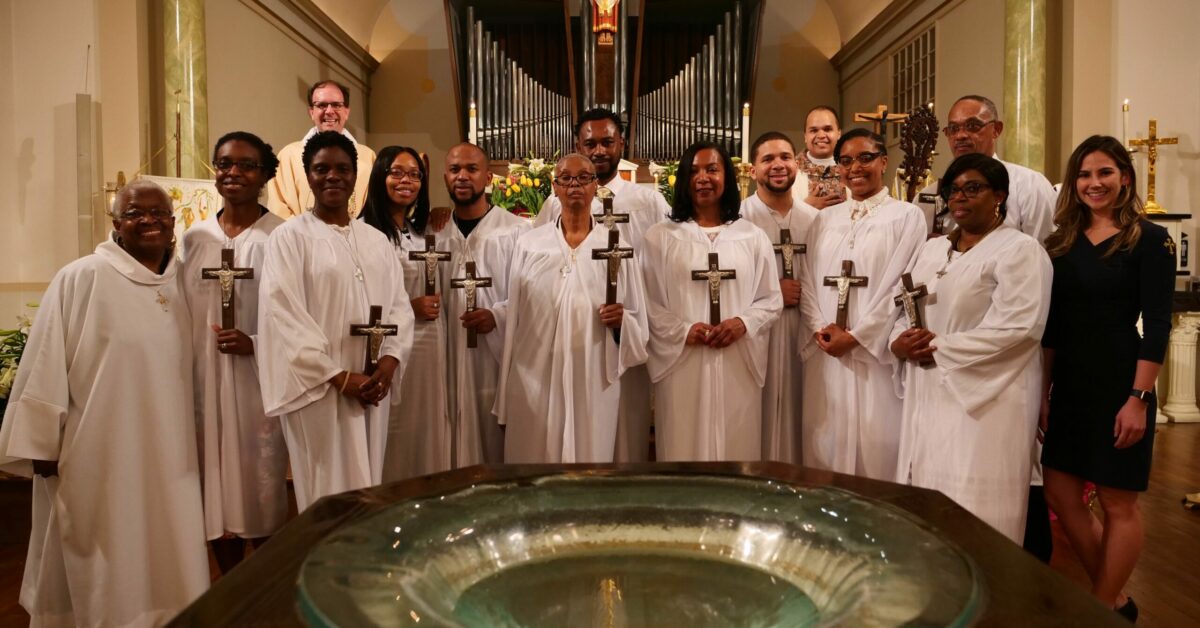Celebrating the Newly Baptized: The Rites of the Mystagogy Period
How can one not love a word like Mystagogy! Prior to Lent we discussed key aspects of the Period of Enlightenment—Rituals, Prayer, Reflection, Catechesis. During Lent we will consider primary aspects of the least well known period of the catechumenate: The Period of Mystagogy. We will consider Rituals, Preaching, Catechesis, Service, and Formation and Vocation over the next five weeks.
Both the RCIA’s description of the Period of Mystagogy as well as that of Go Make Disciples provide a helpful vision of mystagogy. The RCIA describe the period as “a time for the community and the neophytes together to grow in deepening their grasp of the paschal mystery, and in making it part of their lives through meditation on the Gospel, sharing in the Eucharist, and doing the works of charity” (Rite of Christian Initiation, Study Edition, 151). Go Make Disciples describes it in this way: “Mystagogical reflection is guided and sustained contemplation of the church’s worship, especially its sacraments, using biblical themes, images, and stories. . . . it draws Christians to reflect on their experience in worship as an encounter with God, and then to consider the implications for behavior in daily life that reflects faith and belonging to Christ” (Go Make Disciples, 131).
Mystagogy is for the entire assembly. The experience of the neophytes (newly planted baptized) serves as the impetus and source for the sustained (and lifelong) reflection of the assembly of its participation in the paschal mystery. Thus, since the neophytes are the primary symbol there are few formal rituals during this period. The weekly divine service and the Lord’s Supper itself serve as the primary ritual context for reflecting on faith and life in light of experiencing the paschal journey with Christ through baptism, Lord’s Supper, and anointing. At the end of the period, at Pentecost, there should be some celebration of this entire journey with the neophytes and the assembly. This also could include, especially on the Day of Pentecost, a rite of affirmation of vocation. Such a rite is provided in Welcome to Christ, 58-61). In addition, a celebration at the one year anniversary of their incorporation into the body of Christ would be appropriate. Other gatherings throughout the year after their initiations, and perhaps beyond the first year, are also encouraged as desired and feasible.
There are other ways to keep the newly baptized at the center of congregational mission, attention, and reflection. During the fifty days of Easter they could sit in their own area of the church and wear a special symbol denoting that they are newly baptized, such as a cross. They should be included in the intercessions throughout the Easter season. Some may be asked voluntarily to offer witness/testimony to their experience of incorporation into Christ, whether during the divine service or in other forums in congregational life. Every divine service could begin with a rite of remembrance or thanksgiving for baptism, either in addition to or in place of the corporate rite of general confession and absolution. This remembrance of baptism could include the ritual act of sprinkling water upon the assembly as a tangible reminder of baptism (rite of aspersion). The sacramental symbols associated with Easter (font, paschal candle, white paraments and vestments, baptismal candles and robes, alleluia banners, etc…) should have prominence throughout the fifty days.
By means of these rites and ritual accents, as Timothy O’Malley says, “the period of mystagogy is a chance to celebrate the wondrous transformation that has taken place in Christ’s Body” (Divine Blessing, 127). It is a chance to celebrate the new birth in Christ, those newly born in Christ, and all of us who have been born anew in Him.
